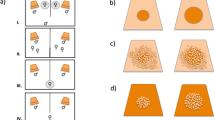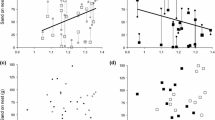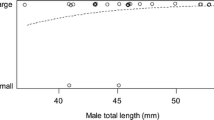Synopsis
Size-assortative choice of nest site is commonly found among fish with paternal care. This pattern can be explained either by the superior competitive ability of large males for preferred large nests, or by a choice of nest size that is related to the male's own body size. Choice of nest size was studied in males of a small marine fish, the sand goby Pomatoschistus minutus, by providing artificial nest sites in laboratory and field experiments. A positive correlation between nest size and male size, indicating a size-assortative nest choice process, was found in both aquarium and field experiments. This is argued to be the outcome of a preference for an optimal nest size and not to be due to competition, as (a) a surplus of nest sites was available to the individuals in nature; (b) in the aquarium experiments, single males of all sizes, when offered a choice between a smaller and a larger nest site, showed a preference for nests in proportion to their body size and not for the largest available nests; and (c) in the aquaria, when single males were offered only a small or only a large nest site, small males abstained from building nests in the large sites, whereas in the small nest sites males of all sizes built nests. My conclusion is that size assortative nest choice occurred in the absence of competition, which thus is not a necessary condition for size-assortative nesting, contrary to what is commonly assumed in many studies. This preference may represent a compromise (or trade-off) between the advantage of a nest large enough to accommodate many eggs and a smaller one with lower maintenance and defence costs.
Similar content being viewed by others
References cited
Arak, A. 1983. Male-male competition and mate choice in anuran amphibians. pp. 181–210. In: P. Bateson(ed.) Mate Choice, Cambridge University Press, Cambridge.
Bisazza, A., A. Marconato & G. Marin. 1989. Male competition and female choice in Padogobius martensi (Pisces, Gobiidae). Anim. Behav. 38: 406–413.
Clutton-Brock, T.H. & S.D. Albon. 1982. Parental investment in male and female offspring in mammals. pp. 223–248. In: K.C.S. Group(ed.) Current Problems in Sociobiology, Cambridge University Press, Cambridge.
Conner, J. 1988. Field measurements of natural and sexual selection in the fungus beetle, Bolototherus cornutus. Evolution 42: 736–749.
Cté, I.M. & W. Hunte. 1989. Self-monitoring of reproductive success: nest switching in the redlip blenny (Pisces: Blenniidae). Behav. Ecol. Sociobiol. 24: 403–408.
Darwin, C. 1871. The descent of man, and selection in relation to sex. First Priceton paperback printing Princeton University Press, Princeton. 475 pp.
Daugherty, R.L., J.B. Franzini & E.J. Finnemore, 1989. Fluid mechanics with engineering applications. McGraw-Hill, Singapore. 596 pp.
Davies, N.B. 1978. Ecological questions about territorial behaviour. pp. 317–350. In: J.R. Krebs & N.B. Davies(ed.) Behavioural Ecology, An Evolutionary Approach, Blackwell, Oxford.
Downhower, J.F. & L. Brown. 1980. Mate preferences of female mottled sculpins, Cottus bairdi. Anim. Behav. 28: 728–734.
Endler, J.A. 1983. Natural and sexual selection on color patterns in poecliid fishes. Env. Biol. Fish. 9: 173–190.
Fonds, M. 1973. Sand gobies in the Dutch Wadden Sea (Pomatoschistus, Gobiidae, Pisces). Neth. J. Sea Res. 6: 417–478.
Forsgren, E. 1992. Predation risk affects mate choice in a gobiid fish. Amer. Nat. 140: 1041–1049.
Gustafsson, L. 1988. Inter- and intraspecific competition for nest holes in a population of the collared flycatcher Ficedula albicollis. Ibis 130: 11–16.
Halliday, T.R. 1983. The study of mate choice. pp. 3–32. In: P. Bateson(ed.) Mate Choice, Cambridge University Press, Cambridge.
Hastings, P.A. 1988. Female choice and male reproductive success in the angel blenny, Coralliozetus angelica (Teleostei: Chaenopsidae). Anim. Behav. 36: 115–124.
Healey, M.C. 1971. Gonad development and fecundity of the sand goby, Gobius minutus Pallas. Trans. Amer. Fish. Soc. 100: 520–526.
Hesthagen, I.H. 1977. Migration, breeding and growth in Pomatoschistus minutus (Pallas) (Pisces, Gobiidae) in Oslofjorden, Norway. Sarsia 63: 17–26.
Jones, G.P. 1981. Spawning-site choice by female Pseudolabrus celidotus (Pisces: Labridae) and its influence on the mating system. Behav. Ecol. Sociobiol. 8: 129–142.
Lindström, K. 1988. Male-male competition for nest sites in the sand goby, Pomatoschistus minutus. Oikos 53: 67–73.
Lindström, K. 1992. Female spawning patterns and male mating success in the sand goby, Pomatoschistus minutus. Mar. Biol. 113: 475–480.
Lindström, K. & M. Hellström. 1993. Male size and parental care in the sand goby, Pomatoschistus minutus. Ethol. Ecol. Evol. 5: 97–106.
Lugli, M. L. Bobbio, P. Torricelli & G. Gandolfi. 1992. Breeding ecology and male spawning success in two hill-stream populations of the freshwater goby, Padogobius martensi. Env. Biol. Fish. 35: 37–48.
Magnhagen, C. & L. Kvarnemo. 1989. Big is better: the importance of size for reproductive success in male Pomatoschistus minutus (Pallas) (Pisces, Gobiidae). J. Fish Biol. 35: 755–763.
Magnhagen, C. & K. Vestergaard. 1993. Brood size and offspring age affect risk-taking and aggression in nest guarding common gobies. Behaviour 125: 233–243.
Marconato, A. A. Bisazza & G. Marin. 1989. Correlates of male reproductive success in Padogobius martensi (Gobiidae). J. Fish Biol. 34: 889–899.
Miller, P.J. 1984. The tokology of gobioid fishes. pp. 119–153. In: G.W. Potts & R.J. Wootton(ed.) Fish Reproduction: Strategies and Tactics, Academic Press, London.
Miller, P.J. 1986. Gobiidae. pp. 1074. In: P.J.P. Whitehead(ed.) Fishes of the North-eastern Atlantic and the Mediterranean 3 Unesco, Paris.
Morris, D. 1954. The reproductive behaviour of the river bullhead (Cottus gobio L.) with special reference to the fanning activity. Behaviour 7: 1–32.
Partridge, L. & T. Halliday. 1984. Mating patterns and mate choice. pp. 222–250. In: J.R. Krebs & N.B. Davies(ed.) Behavioural Ecology, An Evolutionary Approach, Blackwell, Oxford.
Author information
Authors and Affiliations
Rights and permissions
About this article
Cite this article
Kvarnemo, C. Size-assortative nest choice in the absence of competition in males of the sand goby, Pomatoschistus minutus . Environ Biol Fish 43, 233–239 (1995). https://doi.org/10.1007/BF00005855
Received:
Accepted:
Issue Date:
DOI: https://doi.org/10.1007/BF00005855




